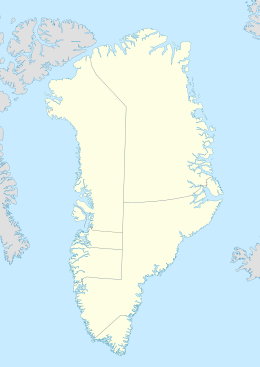Eskimonaes
|
Clavering Ø Nickname: Eskimonæs |
|
|---|---|

Map drawn during Lauge Koch's expedition 1931-1934
|
|
| Clavering Island (Greenland) | |
| Geography | |
| Location | East-Greenland |
| Coordinates | 74°16′N 21°00′W / 74.267°N 21.000°WCoordinates: 74°16′N 21°00′W / 74.267°N 21.000°W |
| Area | 1,535 km2 (593 sq mi) |
| Highest elevation | 1,650 m (5,410 ft) |
| Highest point | Ortlerspids |
| Administration | |
|
Greenland
|
|
| Northeast Greenland National Park | |
| Demographics | |
| Population | 0 |
Clavering Island (Danish: Clavering Ø) is a large island in eastern Greenland off Gael Hamkes Bay, to the south of Wollaston Foreland.
The Eskimonaes (Eskimonæs) radio and weather station was on this island. It was manned by Danish staff and was captured by German troops in 1943. The place where the station stood had also been the location of the last Inuit settlement in Northeast Greenland around 1823.
The island was named by the second German North Polar Expedition 1869–70 as Clavering Insel to commemorate Douglas Charles Clavering (1794–1827), commander of the Griper on the 1823 voyage, which explored the area and, at the southern shore of this island made the first (and last) encounter that Europeans made with the now extinct Northeast-Greenland Inuit.
In late August 1823, Clavering and the crew of the Griper encountered a band of twelve Inuit, including men, women and children. In his journal, Clavering described their seal-skin tent, canoe, and clothes, their harpoons and spear tipped with bone and meteoric iron, and their physical appearance ("tawny coppery" skin, "black hair and round visages; their hands and feet very fleshy, and much swelled"). He remarked on their skill in skinning a seal, the custom of sprinkling water over a seal or walrus before skinning, and their amazement at the demonstration of firearms for hunting.
European visitors to Northeast Greenland prior to 1823 reported evidence of extensive Inuit settlement in the region although they encountered no humans. Later expeditions, starting with the Second German North Polar Expedition in 1869, found the remains of many former settlements, but the population had apparently died out during the intervening years.
Bones of muskoxen have been found at Inuit sites on the island, but no such animals were reported by Clavering in 1823. Large numbers of Arctic hare bones suggest that the Inuit were reduced to hunting smaller game after the extinction of muskoxen in the area. After humans died out, muskoxen returned, and the first pair of live muskoxen ever to be brought to Europe were captured at Clavering Island in 1899.
...
Wikipedia

